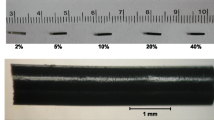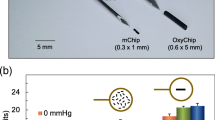Abstract
The development of oxygen-sensitive paramagnetic materials is being actively pursued because of their potential applications forin vivo electron paramagnetic resonance (EPR) oximetry. Among these materials, fusinite is of particular interest because of the high sensitivity of the EPR linewidth to the partial pressure pO2. Although this material has led to a number of very useful results in experimental systems, its potential use in humans is limited by the need to prove that it will not cause deleterious effects. The strategy used in this study to optimize the biocompatibility of the oxygen-sensitive materials was to prepare small silicon implants containing the fusinite. The use of silicon permits the diffusion of oxygen inside the implant while the material does not have contact with the biological environment. Radiosterilization did not affect the pO2 sensitivity of the material. The feasibility of performing pO2 measurement was verifiedin vivo by perodically inducing ischemia in the gastrocnemius muscle of mice over a period of 6 weeks.
Similar content being viewed by others
References
Swartz HM, Boyer S, Gast P, Glockner JF, Hu H, Liu KJ, Moussavi M, Norby SW, Walczak T, Vahidi N, Wu M, Clarkson R (1991) Measurements of pertinent concentrations in vivo.Magn Reson Med 20: 333–339.
Swartz HM, Back G, Gallez B, Goda F, James P, Jiang J, Liu KJ, Mader K, Nakashima T, O'Hara JA, Shima T, Walczak T (1995) In vivo EPR spectroscopy. InBiomdicals Detected by ESR Spectroscopy, Eds (Ohya-Nishiguchi H, Packer L, eds) Birkauser Verlag: Basel, p. 285–299.
Swartz HM, Bade G, Friedman B, Goda F, Grinberg O, Hoopes PJ, Jiang J, Liu KJ, Nakashima T, O'Hara JA, Walczak T (1994) Measurements of pO2 in vivo, including human subjects, by electron paramagnetic resonance. InOxygen transport to issue XVI (Hogan MC et al., eds) New York: Plenum Press, p. 119–127.
Vahidi N, Clarkson RB, Liu KJ, Norby SW, Wu M, Swartz HM (1994) In vivo and in vitro EPR oximetry with fusinite: a new coal-derived, particulate EPR probe.Magn Reson Med 31: 139–146.
Zweier JL, Chzhan M, Ewert U, Schneider G, Kuppusamy P (1994) Development of a highly sensitive probe for measuring oxygen in biological tissues.J Magn Reson B 105: 52–57.
Bade G, Liu KJ, O'Hara JA, Harris RD, Szybinski K, Goda F, Swartz HM (1993) Oxygen tension in a murine tumor: a combined EPR and MRI study.Magn Reson Med 30: 568–572.
Wu MX, Swartz HM (1994) Evaluation of the potential cytotoxidty of some paramagnetic materials used in measurement of the concentration of oxygen.Current Topics in Biophysics 18: 74–80.
Swartz HM, Liu KJ, Goda F, Walczak T (1994) India ink: a potential clinically applicable EPR oximetry probe.Magn Reson Med 31: 229–232.
Goda F, Liu KJ, Walczak T, O'Hara JA, Jiang J, Swartz HM (1995) In vivo oximetry using EPR and india ink.Magn Reson Med 33: 237–245.
Goda F, O'Hara JA, Rhodes ES, Liu KJ, Dunn JF, Bacic G, Swartz HM (1995) Changes of oxygen tension in experimental tumors after a single dose of X-Ray irradiation.Cancer Res 55: 2249–2252.
Nilges MJ, Walczak T, Swartz HM (1989) 1 GHz in vivo ESR spectrometer operating with a surface probe.Phys Med 2: 195–201.
Hennig J, Naureth A, Friedberg H (1986) RARE imaging: a fast imaging method for clinical MR.Magn Reson Med 3: 823–833.
Mäder K, Gallez B, Swartz HM (1996). In vivo EPR: a new tool for studying pathophysiology, physiology, and pharmacology. Appl Radiat Isot (in press).
Gallez B, Bacic G, Goda F, Jiang JJ, O'Hara JA, Dunn JF, Swartz HM (1996) Use of nitroxides for assessing perfusion, oxygenation, and viability of tissues. In-vivo EPR and MRI studies.Magn Reson Med 35: 14–19.
Dunn JF, Ding S, O'Hara JA, Liu KJ, Rhodes E, Weaver JB, Swartz HM (1995) The apparent diffusion constant measured by MRI correlates with pO2 in a RIF-1 tumor.Magn Reson Med 34: 515–519.
Duffy MJ, Woods JE (1994) Health risks of failed silicone gel breast implants: a 30-Year clinical experience.Plast Reconstr Surg 94: 295–299.
Liu KJ, Grinstaff MW, Jiang J, Suslick KS, Swartz HM, Wang W (1994)In vivo measurement of oxygen concentration using sonochemically synthesized microspheres.Biophys J 67: 896–901.




